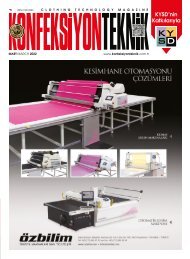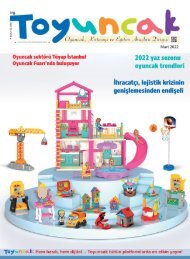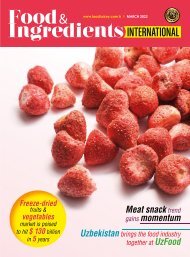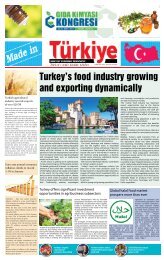Create successful ePaper yourself
Turn your PDF publications into a flip-book with our unique Google optimized e-Paper software.
46 İNCELEME
Böylece buharlama kabini bulutlanır.
Eğer bu fikre eğer katılmayan olursa, lütfen
küçük bir deneme yapmasını isteyin.
Aynı kumaşı kuru koşullarda, aynı reçete
ve buharlayıcı koşullarında emprenye
edin ve sonuçları karşılaştırın!
4.5 Giriş Su Sıkma , E pu
ve “Beyaz Bantlar”
Yukarıda belirtilen tüm problemlerle bağlantılı
olarak “beyaz bant” problem de
söz konusudur. Aslında, beyaz bant olayı
çok nadiren ortaya çıkar, ancak meydana
geldiğinde çözülmesi pahalı ve zor
bir sorundur. Beyaz bantlar bir konveyör
bandı kullanılarak yapılan kasar işleminden
sonra görülebilir. Bu bantlar ağartılmış
kumaş üzerinde atkı ipliği yönünde,
yaklaşık 5 ila 10 cm genişliğinde, eşit
aralıklarla ve 10 ila 20 metre arasında değişen
mesafelerde tekrarlayacak şekilde
görülebilirler. Beyaz bantlar, kumaşın bu
kısımlarının diğer kısımlardan daha fazla
ağartılmış olduğunu gösterir. Henüz teyit
edilmemiş olmasına rağmen, bu sorunun
konveyör bant rolikleri üzerindeki pilelenmiş
kumaşın üst ve alt kısmı arasındaki
sıcaklık farkları, kumaş üzerindeki yüksek
pick-up ve düşük yer değişim faktörünün
biraraya gelmesiyle oluştuğuna dair güçlü
göstergeler vardır. Özellikle buharlama
ünitesinin alt kısmında bulunan sıcaklık
farklılıkları dikkatle gözlenmelidir, bu
bölgede kumaş üzerinde buhar yoğunlaşması
tehlikesi bulunmaktadır. Yukarıda
bahsi geçen varsayımın doğru olup
olmaması tartışma konusu değil, önemli
olan bu varsayımın daha çok gözlemlenen
bir gerçeklere dayanmasıdır. Bu
da, beyaz bant olayı gözlemlendiğinde,
takip edilmesi gereken iki ana nokta
olduğu anlamına gelir:
1) Buharlama kabinindeki buhar koşullarına
dikkat edin
2) Flote yer değişiminin etkisini en aza
indirmek için yüksek basınçlı giriş su
sıkması (Q1) değerine bakınız.
Örneğin, Çıkış Kimyasal Sıkma (Q2)
değerinin düşürülmesi durumunda,
artırılan basınç çözelti ilavesi (add-on)
mikatrını düşürecektir ancak daha
tehlikeli bir başka şeye neden olarak
and a direct injection of all chemical components it
can happen that the feeding pipe is getting so hot
that it is barely touchable. The lower the effective
pick-up the higher the concentration of caustic
and peroxide! Here we refer to the formula of the
concentration of the feeding liquid:
R∆Q
Apart from the cost, increasing a stabiliser is no go,
this will not work. What will help is lowering the values
of Q1, with a lower Q1 we automatically will get a
higher E pu
and can eliminate a dangerous situation.
4.4. The water squeezer, E pu
and Fog in the steamer
Since the appearance of the maximum add-on
units, Fog in the steamer is a well-known problem.
This problem is directly linked to the low exchange
during the impregnation and the high add-on after
the impregnating. Fig.12 makes this more comprehensive,
a low exchange invalves a high concentration
of the feeding liquid. The water remains in the
centre of the fabric and the chemicals, with their
high concentration, stay on top of the fabric. This
concentration is very high and the moment such a
cloth enters the steamer peroxide and caustic start
to react and oxygen in form of a very fine mist is
leaving the fabric. The steamer is getting “cloudy”. If
someone disagrees with this, please let them make
a small trial and enter the same fabric in dry conditions,
impregnate with the same recipe and steamer
conditions and compare the results!
4.5. The water squeezer, the E pu
and the “white bands”
Linked with all the above mentioned problems are
the so-called white bands. As a matter of fact, the
phenomena of the white bands will occur very
seldom, but if it does it is a costly and difficult to
fight problem. The white bands are visible after the
bleaching using a conveyer belt. They appear on
the bleached fabric in weft direction, about 5 to
10 cm in width, evenly formed and are repeatedly
visible in distances varying from roundabout 10 to 20
metres. The white bands implicates that the fabric
in this area is more bleached than the other part
of the fabric. Although it is not yet confirmed there
are strong indications that we are dealing with a
combination of the high pick-up and a low exchange
on the fabric together with temperature differences
between the upper and lower part of the piled
fabric on the conveyer belt resp. rollerbed. Especially
the temperature differences existing in the lower
part of a steamer needs to be observed with care,
here is an eminent danger of condensation of steam
TEKSTİL & TEKNİK | OCAK | JANUARY | 2021
















